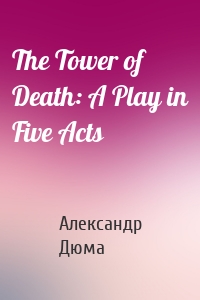Александр Дюма
301 кн.
The Mad Marquis
Written in 1836, this collaborative play is based on a real-life incident, using the actual names of the principals involved. The young Marquis de Brunoy is snubbed at the French Royal Court of Versailles because his father, a financier, had been ennobled for his great wealth. After having to fight several duels to defend his honor, the Marquis strikes back by disregarding his rank and wealth, and associating with peasants and artisans as equals. The more extravagant that his behavior becomes,...
| Автор | Александр Дюма |
The Gold Thieves
Dr. Ivans, unable to make a living in London, migrates with his two daughters to Australia, where he hopes to make his fortune; one of his girls, Melida, is forced to leave her suitor, Williams, behind. Arriving in Australia, Ivans finds himself unable to improve his fortune–he's too willing to help the poor, and has a good reputation for charitable works. Then a group of gold miners, a motley crew of Frenchmen, send for him to heal a young miner who's dying. This poor lad was stabbed...
| Автор | Александр Дюма |
Bathilda: A Play in Three Acts
Adapted by Alexandre Dumas from a script by Auguste Maquet, BATHILDA tells the story of a woman who's raped by Marcel, and becomes his lover for a time. After she leaves him and moves to Paris, she meets Deworde, her deceased spouse's nephew, and plans to marry him. But Marcel pursues her, determined that if he can't have her, no one else will either. He plays a cat-and-mouse game with Bathilda, Deworde, and his friend Guilaumin, until their final confrontation. Will Marcel have...
| Автор | Александр Дюма |
The Three Musketeers (Mermaids Clas...
"The Three Musketeers" (1844) was written by the French author Alexandre Dumas (1802-1870) who also wrote the famous classic "The Count of Monte Cristo". "The Three Musketeers" are three close friends named Aramis, Porthos and Athos and the story follows the adventures of another young man named d'Artagnan who leaves home in order to join the Musketeers of the Guard.<br><br>Mermaids Classics, an imprint of Mermaids...
| Автор | Александр Дюма |
The Count of Monte Cristo, Part Two...
The Count of Monte Cristo, one of the greatest adventure novels of all time, has been converted by the author into a series of four plays. In PART TWO, Edmond Dantes has escaped from the dreaded prison island of d'If after 14 years of captivity. He seeks out the fabulous treasure of Monte Cristo described to him by the Abbe Faria, and assumes the identity of the priest Busoni. Then he begins his odyssey of revenge, tracking down Caderousse and his wife, La Carconte, and finding the trail of...
| Автор | Александр Дюма |
The Corsican Brothers: A Play in Th...
This adaptation of the Alexandre Dumas tale tells the story of two brothers, born as Siamese twins, but separated not long after birth. They're raised by two different families, but are still able to «feel» the emotions of the other, even at a distance. On the island of Corsica they become entwined in the long-running feud between the Orlandi and the Colonnas–a dispute that had its beginnings in a dispute over the ownership of a chicken! Most of the two families have now been eliminated...
| Автор | Александр Дюма |
Queen Margot: A Play in Five Acts
Written in 1847, while Dumas was at the height of his powers, this play recounts the events leading up to the Saint Bartholomew's Day massacre of the French Huguenots–and the subsequent death of King Charles IX. The playwright focuses on the people inadvertently caught up in the slaughter–which, once started, cannot be repressed. By following the fate of two nobles, the Catholic Count Coconnas and the Huguenot Count de la Mole, and linking their stories to Queen Marguerite (called Margot),...
| Автор | Александр Дюма |
Sylvandire: A Play in Four Acts
In 1844-45, while Alexandre Dumas was working on his two classic novels, The Three Musketeers and The Count of Monte Cristo, he found time to write a play called Sylvandire. A young provincial, Roger Tancred d'Anguilem, arrives in Paris to fight a legal battle for a huge inheritance. His opponent is an Indian called Afghano, who has bribed the judges. The case appears lost until Roger's approached by a sleazy lawyer who promises him success–but only if he marries a woman sight unseen....
| Автор | Александр Дюма |
The Tower of Death: A Play in Five...
Tour de Nesle (The Tower of Death) is one of Alexandre Dumas's greatest and most powerful plays, a tale of power and conviction, although its historical accuracy is far from certain.<P> Queen Marguerite and her sisters entertain themselves by luring unsuspecting men to the Tower, which located across the Seine from the Louvre. There they entice their victims to join them for wild sexual escapades–all expressly forbidden, of course, by both Church and State. Once satiated, the ladies...
| Автор | Александр Дюма |
The Last Cavalier: Being the Advent...
The lost final novel by the master of the epic swashbuckling adventure stories: The Count of Monte Cristo and The Three Musketeers.The last cavalier is Count de Sainte-Hermine, Hector, whose elder brothers and father have fought and died for the Royalist cause during the French Revolution. For three years Hector has been languishing in prison when, in 1804, on the eve of Napoleon's coronation as emperor of France he learns what is to be his due. Stripped of his title, denied the honour of his...
| Автор | Александр Дюма |

























